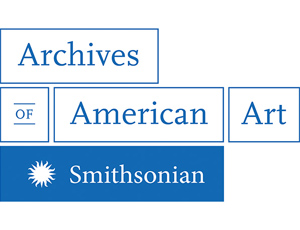New Collections: Connie Zehr Papers and Cherie Raciti Papers
Gerald and Bente Buck West Coast Collector Matthew Simms reflects on two new collections of women artists now at the Archives of American Art.
:focal(500x319:501x320)/https://tf-cmsv2-smithsonianmag-media.s3.amazonaws.com/filer_public/93/f8/93f85a33-972b-4e62-bc41-cabd92f37edd/simms_fig_1-fig_2_siv.jpg)
Two new collections deepen the Archives’ growing holdings of papers related to California women artists. The Connie Zehr Papers, donated by the artist (b. 1938), contain a wealth of documentation regarding her mysterious sand installations, which often included silica of various colors combined with organic materials such as unfired clay forms, granite rocks, broken glass, and chicken eggs. Clippings, photographs, and exhibition catalogues trace Zehr’s growing ambitions in gallery and museum installations, first in the Los Angeles area and then in cities such as Chicago, New York, and Milan. Photographic contact sheets, dating from 1970, show the artist surrounded by a team of helpers, sifting sand through fabric membranes to create hillocks of fine, virginal powder. And yet, as a review included in her papers observes, the artist was equally keen to disturb the carefully formed sandpiles. As part of a sculpture exhibited in 1972, for example, she dragged a rope through and dropped a rock onto some of her dunes, leaving scars and craterlike indentations in their pristine surfaces.
Zehr’s papers include more than fifty sketchbooks and journals dating from the late 1960s through 2020, in which she chronicled day-to-day activities and recorded intimate thoughts about relationships, dreams, and aspirations. Researchers will marvel at the many drawings, pasted-in clumps of animal fur, and pressed flower petals that animate these pages. They will also find documents in the papers related to Zehr’s role as a member of Womanspace, a Los Angeles gallery which, in the early 1970s, offered women artists spaces to exhibit their work and discuss challenges facing them. Among such documents is a marked-up copy of the gallery’s bylaws, on which Zehr highlighted topics she felt needed more discussion or, conversely, underscored points she wanted to affirm. Above all, the papers attest to the artist’s commitment to an art of subtlety and ephemerality. “Temporary installations have been my medium for exploring themes of change,” explains Zehr, in an undated statement preserved in her papers. “The sand is literally a landscape, but placed in a gallery it evokes a more poetic sensation of place.”
The Cherie Raciti Papers reveal another California artist’s preoccupation with materials. Unlike Zehr, however, Raciti (b. 1942) was drawn to synthetic, industrially-produced materials, including polyester resin, fiberglass, liquid acrylic, and other plastic-based supports. In her San Francisco studio, Raciti concocted mixtures of resins, catalysts, and plasticizers, which she squeegeed onto fiberglass supports with ragged, frayed edges. “Much of what occurs is dictated by the materials,” explains Raciti, in extensive studio notes at the Archives: “The surface is usually a spontaneous result of the process.” A sketchbook dated 1971–72 documents Raciti’s material investigations, in which she studied the effects of overlapping swatches of opulent and colorful liquid polyester. A photograph of Raciti in her studio illustrates that she worked in a sealed-off area, which allowed her to protect her sticky substances from dust and other airborne particles.
/https://tf-cmsv2-smithsonianmag-media.s3.amazonaws.com/filer_public/ad/0a/ad0a9c0f-f46d-4072-9cbb-dc7cc7179418/simms_fig_3a-3b_siv-horizontal.jpg)
Correspondence, biographical notes, catalogues, clippings, and photographs chronicle Raciti’s many gallery and museum shows in San Francisco, Berkeley, Los Angeles, and New York. And yet, Raciti is perhaps best known for the murals she secretly installed in and around the San Francisco Redevelopment Zone. Starting in the summer of 1973, she began laminating large sheets of acrylic polymers and synthetic fibers directly to the exposed walls of partially demolished hotels or the structural remnants of what were once basements and parking garages. Photographs in the collection documenting these trespass paintings and announcements sent to friends show how she spread the word about her stealth interventions. In the late 1970s, Raciti continued to work anonymously in urban environments, this time by spray-painting ringlike emblems directly on city sidewalks and streets in San Francisco, Oakland, and Los Angeles. Documents in her papers record these impermanent gestures, which she dubbed Street Talk. A 2011–12 sketchbook includes samples of fibrous Japanese paper, which the artist cut in spiral shapes that seem to spin on the page, calling to mind at once atomic particles and distant galaxies.
These new collections highlight how each artist, one based in Southern California and the other in Northern California, engages with materials as part of what they describe as a spiritual quest for heightened awareness or, at least, for greater sensitivity to the sheer beauty of matter, be it organic or synthetic. The Connie Zehr Papers include ample evidence of the artist’s abiding fascination with delicacy, impermanence, and the poetry of place. The Cherie Raciti Papers, joining a small segment donated in 1986, offer a comprehensive perspective on the equally evocative investigations of this fascinating Bay Area artist.
This text originally appeared in the Spring 2022 issue (vol. 61, no. 1) of the Archives of American Art Journal.
